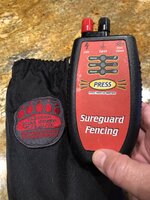Robinhood21
WKR
Has anybody actually touched or grabbed and felt the shock of this?
I got it all set up and really wanted to test it so I barely grazed my hand on it and felt nothing then I ran my hand along the wires I could feel a little “tingles”. Then I just grabbed it and held on and once again just tingles..... not very SHOCKING.
I went over everything three times and everything is set up perfectly. Put new batteries in, made sure the alligator clips were on lengthwise, and touching plenty of wires etc.
I’m afraid most people buy this don’t even really test it out. I did read a couple reviews where a guy said that the shock was so light it wouldn’t be able to keep a squirrel out.
Does anybody have similar experiences? Different experiences? Let me know thanks
Sent from my iPhone using Tapatalk
I got it all set up and really wanted to test it so I barely grazed my hand on it and felt nothing then I ran my hand along the wires I could feel a little “tingles”. Then I just grabbed it and held on and once again just tingles..... not very SHOCKING.
I went over everything three times and everything is set up perfectly. Put new batteries in, made sure the alligator clips were on lengthwise, and touching plenty of wires etc.
I’m afraid most people buy this don’t even really test it out. I did read a couple reviews where a guy said that the shock was so light it wouldn’t be able to keep a squirrel out.
Does anybody have similar experiences? Different experiences? Let me know thanks
Sent from my iPhone using Tapatalk


